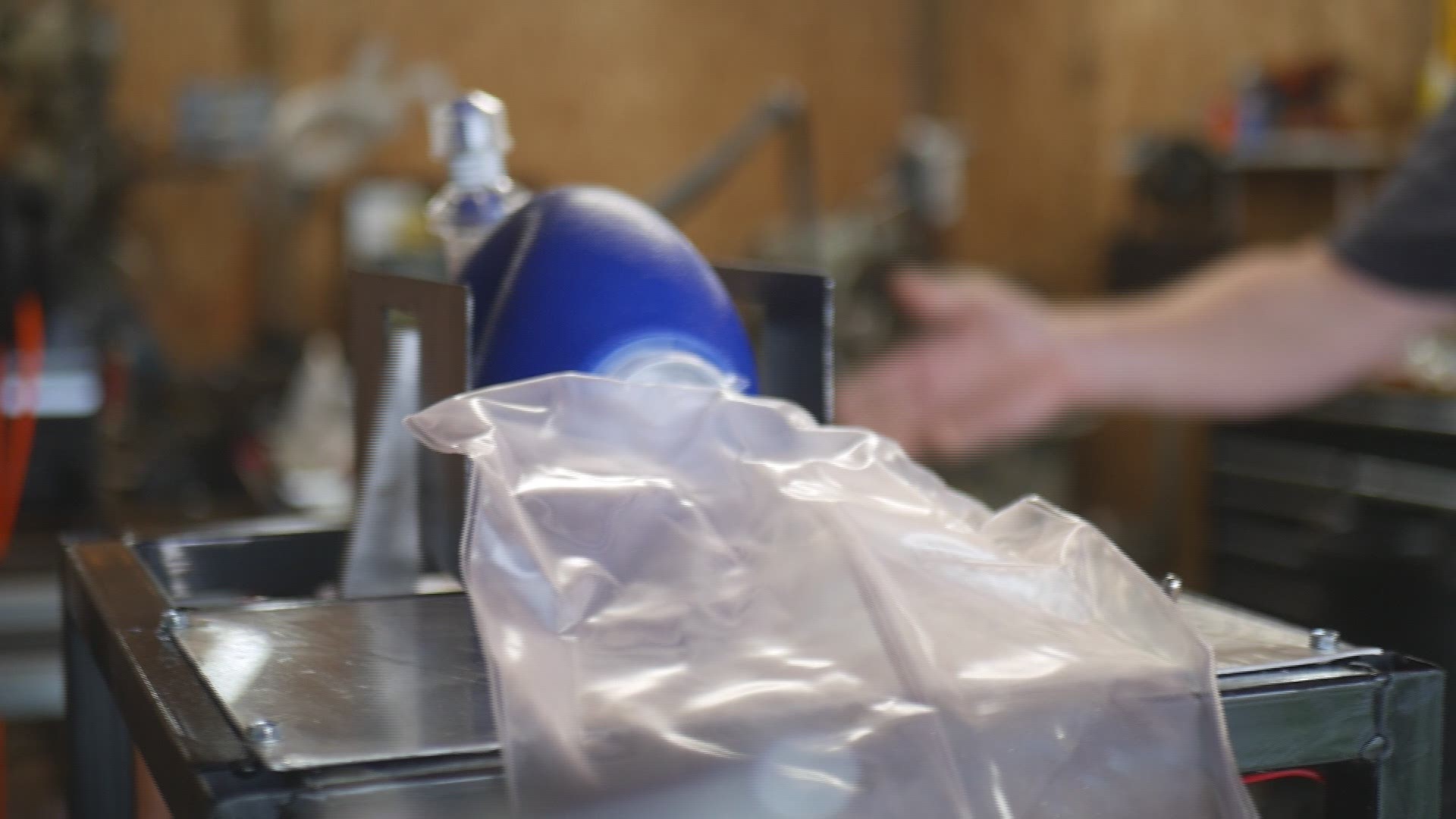STARLIGHT, Ind. — It was born as an idea only a week ago, and turned into a reality two days after that in a Southern Indiana shed.
Scott Merritt-Jenney had seen the news of hospitals around the country growing increasingly concerned about the supply of ventilators, and decided he wanted to help.
"The more I thought about it the more I could see why this would work and that would work and gosh, I could probably do that in my garage at home so I did," Jenney said.
Jenney is an industrial automation and fabrication technician, with previous experience in the medical field, and currently working with woodworking machines. With his experience, Jenny knew he could build a ventilator. It only took him two days to create a prototype of a ventilator.
"I just started thinking of a design in my head and some ideas popped in immediately to use what I'm familiar with, which is industrial automation equipment which is readily available off the shelf stuff," he said. "So I ordered some parts online and they came in a day or so and I went to work in my welding shop and my machine shop and by Friday I had a working prototype."
As he was coming up with the idea, Jenney called his longtime friend, Dr. Roy Givens. Givens is an E.R. doctor at the VA hospital in Lexington.
"When Scott called me, I was very excited and thought that this would be a good idea to pursue this," Givens said. "It's good to see some good ol' fashioned Indiana ingenuity going on here."
Givens said working on the front lines right now as the coronavirus spreads, he sees first-hand the need for ventilators.
"We're on the front lines with this, and we're all, quite honestly afraid that we're gonna be choosing between life or death for people because we're not going to have enough equipment," Givens said.
That's what pushed the two to get involved in creating a ventilator. The prototype Jenney has built is an automated ventilator like those used in hospitals currently, but it's a simpler version meant to be easy to use by any paramedic or nurse.
"Basic, no frills sort of thing but it's designed to save lives in a pinch. This is not the ventilator you want to be on for months and months and months," Givens said. "This is something that's going to help us out if we simply don't have another alternative."
The ventilator Jenney has designed does not have some of the high-tech features of the current ventilator versions used in hospitals. The goal, both Jenney and Givens said, is to create a ventilator that can be produced quickly and efficiently to get to healthcare workers now while there's an immediate need.
"He's really building something that essentially uses the bag as the ventilation chamber in a ventilator," Givens said.
The two are working through a few hurdles, as they ensure the prototype meets the medical needs of healthcare workers using ventilators for coronavirus patients.
"To make sure that the exhaust gas from the ventilator is filtered, and how to filter the intake air," Givens said. "And how we can make sure the ventilator will alarm if it were for some reason to be disconnected, et cetera."
Jenney said the ventilator can also be made more cost-efficiently than current ventilators used in hospitals.
"You could build half a dozen of these for every one that you could purchase that is currently on the market and probably build them twice as fast," he said.
While the ventilator, once manufactured and produced, could be used all over the country to help COVID-19 patients, Dr. Givens said he sees a use for the product well beyond that. He said their version of the ventilator runs off the equivalent of two car batteries, allowing it to potentially be used by medics in the field.
Right now, their focus, though, is to work quickly, because they said they know "time is of the essence." Jenney estimated if a few more things fall in to place, they could have ventilators being made in one to two weeks.
"The good news from what I'm hearing from New York, the vast majority of patients that end up on a ventilator, believe it or not, are coming off the ventilator," Givens said. "The bad news is they're on the ventilators for nine days, so we're going to need a lot of ventilators."
All of the ventilator's parts and controllers are off-the-shelf parts, according to Jenney. What the pair needs, is some help finalizing the product's engineering to turn it into a form that's ready for manufacturing. They also need to establish a supply chain of the components needed to build the product in large numbers.
"If there is anyone out there that can and would be willing to help, that's what we need most right now," Jenney said.
"I'd like to think that maybe we could rise to the challenge and to put together something that will get us through the crisis," Dr. Givens said.
If you'd like to help or know someone who can, the two ask you to contact either Scott Merritt-Jenney at (502) 551-2142 or Dr. Roy Givens at Rgivens3@bellsouth.net.
►Make it easy to keep up-to-date with more stories like this. Download the WHAS11 News app now. For Apple or Android users.
Have a news tip? Email assign@whas11.com, visit our Facebook page or Twitter feed.

